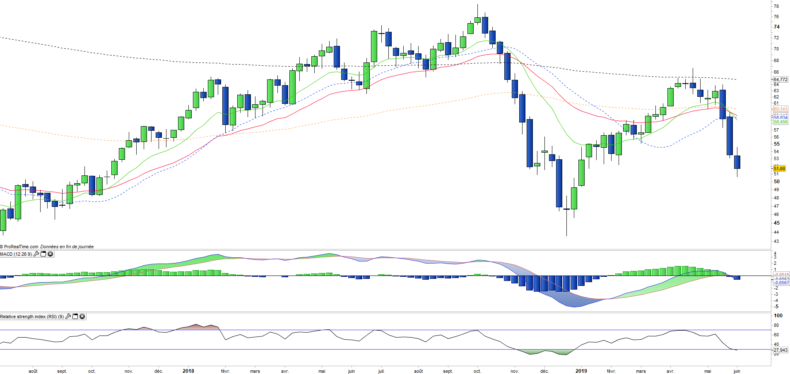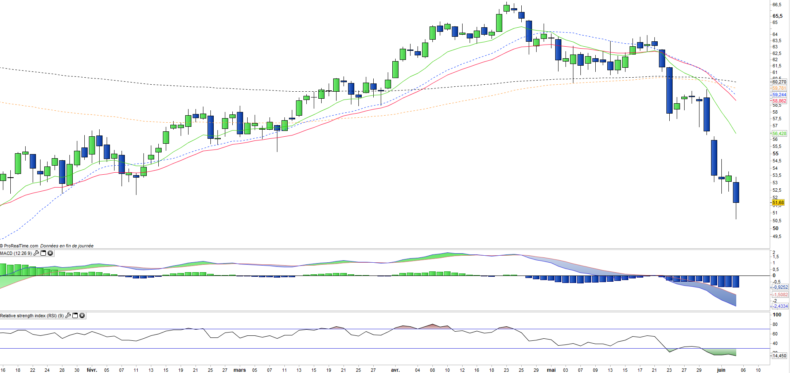Oil WTI - CLXXXX - 06/06/19
Short Term trend: Negative (0/100)
Long Term trend: Negative (0/100)
(scores computed by our proprietary algorithms - cf methodology)
to access to our Buy / Sell signals
on ETFs and Stocks
Profile
Oil is a raw material that is a fossil fuel produced by a few countries like Saudi Arabia, the US, Russia, Iran, Iraq, Algeria or Nigeria. It is extracted by drilling or hydraulic fracturing and is then delivered - processed / refined or not, in consumer countries, mainly European and Asian and can produce fuels such as gasoline, gas oil or kerosene once refined and processed chemically.
Depending on its origin and final destination, oil has different names and its price may also vary. These differences in the price of oil depend on its quality. We differentiate the Arabian Light, which comes from the Middle East, the Brent oil that is produced in the North Sea, and finally the WTI or "West Texas Intermediate" which is produced in the United States and is the benchmark of the oil market. The reference unit for oil is the barrel, which is actually about 159 liters.
The price of a barrel of oil is quoted on the international market continuously, while two financial centers share its rating, namely New York for WTI and London for Brent. Supply, therefore production and its stability are of course key determinants of the price of a barrel. It is OPEC, made up of several major world producing countries, which is in charge of determining - by consensus - how many barrels a day will be produced and its publications are therefore followed with attention by traders, as was the case recently.
Demand factors are also critical. Thus, an increase in the energy needs of a major consumer country may have a greater or lesser influence on the price of the barrel.
Globally, global growth is a very important factor for demand, while oil needs tend to shrink at equal demand, as new technologies tend to reduce consumption. In the long term, the electric car could cause a negative shock on global demand for crude oil, as China is investing heavily in renewable energy. Since 2014, oil prices have divided by 3 due to a supply shock caused by the arrival on the market of American shale oil which has put very strong pressure on the oil-producing and oil companies that have significantly reduced their investments. This stoppage of industrial investment, in addition to OPEC's production cuts, has for the moment had a moderate bullish impact on crude prices. This is due to the plethoric production of unconventional oil (shale) that floods the market and counterbalances OPEC's reduction efforts.
WTI oil rebounded 14.5% since the beginning of the year, but turned sharply down in May after the failure of negotiations between China and the US. Supply issues remain and are mainly related to geopolitics (Libya, Venezuela, Iran) or more structurally to the production gap, but concerns about demand are even stronger, while rising tensions between China USA are likely to cause a global recession.
Instruments : OLO (Deutsche Bank USD), BNO (US Commodity Fund USD), OILWP (ETFS in Euro),
Technical analysis
Weekly data analysis
The weekly chart shows a sharp break in the medium-term trend of two large bearish candlesticks, which together account for a nearly 20% drop in prices. This configuration is reminiscent of last winter with a decline of a high amplitude but mostly continuous for almost 2 months. The crossing of the MACD confirms the negative orientation in the short and medium term. The downturn is validated on a medium term horizon.
Daily data analysis
On the daily chart, you can see the drop in prices which corresponds to the break of the $ 60 level, which corresponded to a significant psychological level and a major support, reinforced by the presence of the EMA100 and 200. There is more really support before the trough of December 2018 located at around $ 43. The big bearish candlesticks show some early signs of panic and create a situation of oversold, but that is not enough for the moment to justify a credible rebound.


